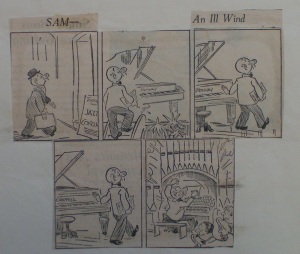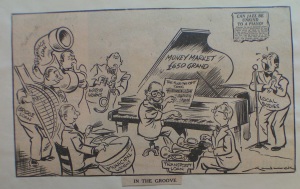It may seem curious from a twenty-first century perspective that jazz concerts could ever be controversial, but in 1950s New Zealand this is what happened. The first formal jazz concert was held in August 1950 (which I will detail along with the jazz concert concept in another post) but that was the beginning of a trend in the New Zealand jazz scene. This trend was helped by the fact that the music scene was in flux- the tastes of dance music were changing and non-dance venues were becoming popular venues for jazz. In addition the jazz concert held in halls and parks meant that children could attend with their parents so the jazz concert could be touted as a night out for the whole family.
However, the concerts were not without controversy. Various councils in the early and mid–1950s were concerned about whether they should let the organisers of jazz concerts use the Town Halls, and importantly whether they should allow musicians to use the grand pianos.[1] On one particular occasion in early September 1952, the Auckland City Council banned jazz musicians from using the newly purchased Steinway grand piano after they were informed that the musicians had hammered the piano “with both hands and feet.”[2] This assumed pummelling had supposedly detuned the piano and caused problems with the pedal mechanism.
Jazz musicians and audience members refuted this allegation, stating that they had not hammered the piano, and had barely used the pedals. Two of the pianists that participated in the concert, Monte Oliver and Julian Lee, both stated to the press that they had found the piano to be out of tune and of inferior quality, and would have preferred to play on the older Chappell grand if it had not been awkwardly positioned on the stage.[3] In addition to this defence, the New Zealand Herald interviewed some of Auckland’s leading piano teachers, including the head of Auckland University College’s Music Faculty, who all stated that while it was theoretically possible that damage could have occurred it was probably no more or less likely than damage occurring from a classical pianist.[4]
A similar incident in Whangarei inspired a satiric article in the Northern Advocate which stated: “A new committee, to be known as the Committee for the Prevention of Piano–Thumping, may shortly be set up by the Whangarei Borough Council to carry out its ban of bebop on the Bechstein.”[5] According to the article committee members would attend concerts and if they decided that the pianist had drifted “into a jazz tempo, it will be the committee’s duty to rush to the stage and stop the pianist immediately.”[6]
It appears that many people, whether or not they enjoyed jazz, thought that a small cadre of classical music fanatics (who were out of touch with all modern music) was over–influencing council committees decisions. This feeling led to debates in letters to the editor columns about purpose of such expensive instruments in Town Halls: were they there to satisfy a small cadre of musicians and society, or were they meant to be used by all musicians for all purposes?[7] While these letters were not necessarily a statement of support for jazz musicians and their concerts, they were a statement supporting egalitarianism for the use of town halls, and their instruments, by all types of musical groups.
These and other similar incidents indicate that among certain sections of town councils jazz was still viewed as rather risky (and possible risqué) entertainment. While the council committees involved in the two aforementioned incidents were worried about their expensive grand pianos, others were concerned about the types of people these concerts were attracting, and the behaviour of the audience. Many officials were concerned about patrons dancing in the aisles, the foyer, or other areas, and generally acting in, as one council officer put it “an unseemly manner.”[8] Such behaviour resulted in concert organisers being informed that if they could not control the audience’s behaviour then Town Halls would be unavailable for booking.
These problems were understandable in the first year or two of the concerts around the country: initially no one involved in the jazz concerts, musicians, councils, or the audience, really had any idea about what would happen at a jazz concert. However, these were not isolated or early problems. These conflicts regularly occurred between jazz concert organisers and council committees into the mid–1950s. It appears that although the concerts were popular with jazz fans and parts of the general public, this popularity might have contributed to the problems, especially regarding audience behaviour. Eventually, however, the behaviour of audiences changed. From about 1956 there appear to have been fewer complaints about audiences’ bad behaviour, and a number of reviews of jazz concerts from this time remarked on the quietness of audiences.[9]
[1] ‘Protests’, AS 2/9/1952, 1; ‘The Grand is not for Jazz!’ NZH 4/9/1952, 10.
[2] ibid.
[3] ‘We Don’t Like the Steinway Anyhow!’, AS 3/9/1952 1; NZH Letters to the Editor 4/9/1952, 8; 8/9/1952, 6.
[4] ‘Can Jazz Be Unkind to a Piano?’ NZH 3/9/1952, 10.
[5] A.J. McCarthy ‘Dr Buckley’s Bon Mot on bebop Ban on Bechstein’ NZ14/2/1953.
[6] A.J. McCarthy ‘Dr Buckley’s Bon Mot on bebop Ban on Bechstein’ NA,14/2/1953.
[7] ‘Steinway Jazz’ NZH 8/9/1952.
[8] Letter from Mr Peterson, Town Clerk for Wellington City Council to Vernon Clare, Jazz Concert Organiser 7/12/1955. DHJA Chronological Concert Files, ATL MS-Papers-9018-60.
[9] See for example ‘Cavalcade of Jazz’ 16/2/1956 file DHJA Chronological Concert Files, ATL MS-Papers-9018-60.


